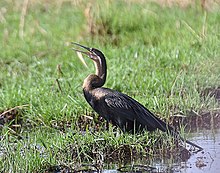African Darter
| African Darter | |
|---|---|
 | |
| At the Chobe National Park | |
| Conservation status | |
| Scientific classification | |
| Kingdom: | Animalia |
| Phylum: | Chordata |
| Class: | Aves |
| Order: | Pelecaniformes |
| Family: | Anhingidae |
| Genus: | Anhinga |
| Species: | A. rufa |
| Binomial name | |
| Anhinga rufa (Daudin, 1802) | |
| Synonyms | |
Anhinga africana
| |
The African Darter (Anhinga rufa ), sometimes called the Snakebird, is a water bird of sub-Saharan Africa.
Taxonomy
The African Darter is a member of the darter family, Anhingidae, and is closely related to American(Anhinga anhinga), Oriental (Anhinga melanogaster), and Australian (Anhinga novaehollandiae) Darters.
Description
The male is mainly glossy black with white streaking, but females and immature birds are browner. The African Darter differs in appearance from the American Darter most recognisably by its thin white lateral neck stripe against a rufous background colour. The pointed bill should prevent confusion with cormorants.
It is an 80 cm long cormorant-like fish-eating species with a very long neck, like other anhingas.
Distribution
The African Darter is found throughout sub-Saharan Africa wherever large bodies of water occur. The bird used to breed there in breeding colonies with Pygmy Cormorant and Sacred Ibis and other waterfowl.
One subspecies, the Levant Darter (Anhinga rufa chantrei), occurred at Lake Amik (Amik Gölü) in south-central Turkey and in the marshes of the lower Euphrat and Tigris rivers in southern Iraq. The Turkish population disappeared during the 1930s, the Iraquian population during the Gulf War in the 1990s.
Behaviour
This species builds a stick nest in a tree and lays 3-6 eggs. It often nests with herons, egrets and cormorants.
It often swims with only the neck above water, hence the common name snakebird. This too is a habit shared with the other anhingas.
Unlike many other waterbirds the feathers of the African Darter do not contain any oil and are therefore not waterproof. Because of this, the bird is less positively buoyant and its diving capabilities are enhanced. After diving for fish, the feathers can become waterlogged. In order to be able to fly and maintain heat insulation it needs to dry its feathers. Thus the African Darter is often seen sitting along the waterside spreading its wings and drying its feathers in the wind and the sun along with cormorants which may share its habitat.

No comments:
Post a Comment